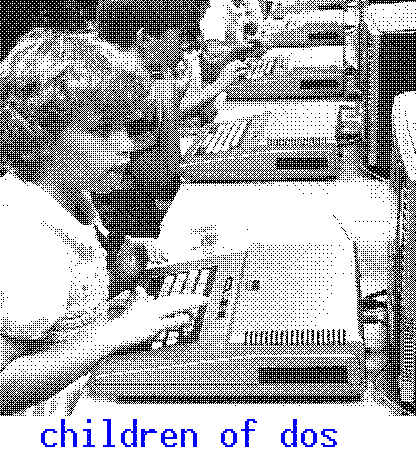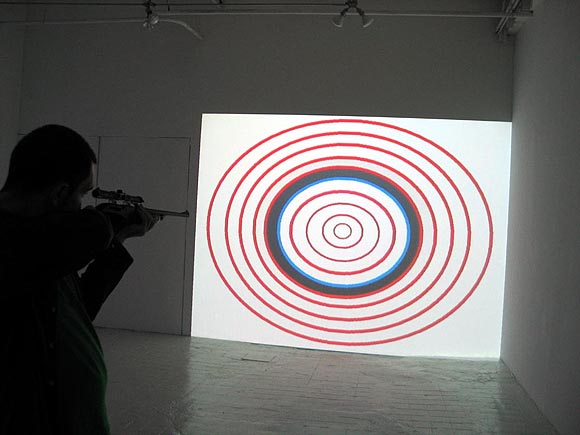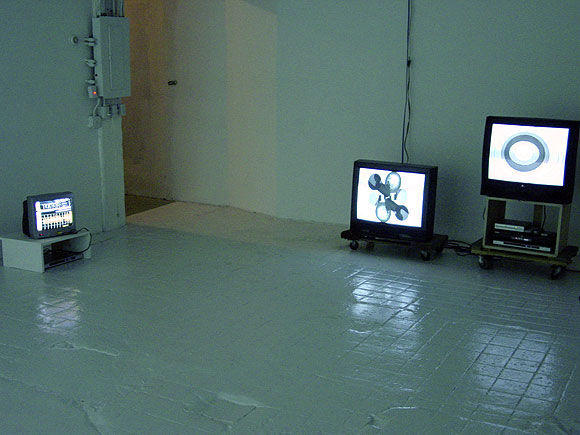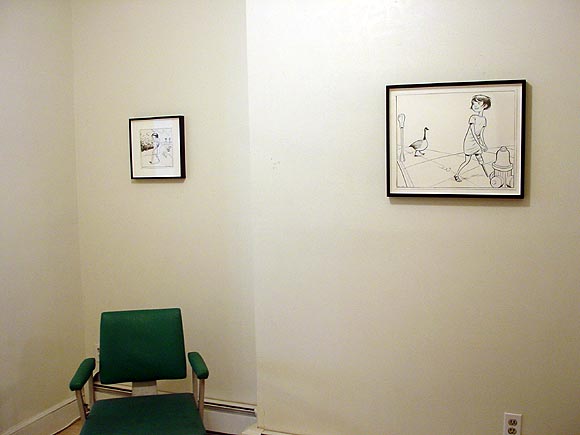View current page
...more recent posts

artist unknown - thanks to MBS for reminding me about that GIF scraper page for LiveJournal - there was so much good stuff I had to stop downloading so I could have a life -
"Amiable Floater" [mp3 removed]
Not that it matters, but the sound generation of this song is 100% analog. The computer was used only to trigger note on/off and velocity and to record and mix. The rest of it's voltages and filtering and a lot of layering. The genesis of it was that the drum machine I'm using has three tunable drums that can either be kicks or toms. I tuned them so the drum hits could be played like a bass line. The piece isn't really all that amiable--it gets a bit mysterious at the end during the "acid" part. The overall texture makes me think a little of Derrick May's work, which was the first techno music I really started studying. Not sure why exactly--kind of a jazzy feel?
It's a good headphone piece, I think.
Every couple of weeks the art and technology website Eyebeam reBlog invites a guest reBlogger to act as a combination curator, editor, and DJ, surfing and reposting noteworthy material from blog feeds. Paddy Johnson criticizes the tendency of the reBloggers of late to rely too much on known "tech news" sites (Make, Boingboing, et al) for recycled material. I agree with her, but then I would, because the practice violates my own self-declared "rules for reBlogging," posted at the end of my gig there in '04.
Generally speaking, there are entirely too many stories in the category Michael Bell-Smith calls Talking Refrigerators.
These are whimsical items about some engineering marvel, usually from a college robotics department or venture capital startup, that are at best consumerist PR and at worst the kind of ridiculous '50s gee whiz utopianism that we all should know by now has a down side and a dark side (just thinking of that nightvision video clip of the helicopter gunner blasting a wounded Iraqi soldier to hamburger--"squeeze the joystick, instant no soldier!").
Case in point: a recently reBlogged item offers a clip from a local news station about an alarm clock that rolls off your nightstand, forcing you to chase it across the floor until you wake up. Hey, that same fuzzy gear could be repurposed to make "rolling landmines" that follow you around till they blow your legs off! Less fluff, more stories about the world we live in I guess is what I'm hoping for.
And from the not-biting-the-hand-too-hard-that-feeds-me department, thanks to L.N.R., George Hotelling, Angus Galloway, Perry Lowe, Huong Ngo, Evan Roth, and David Jacobs for reBlogging me this year--you guys rule!

The critics (i.e., other artists) take aim. Referencing the interview Paddy Johnson did with Michael Bell-Smith and me, Joe McKay recently posted a comment that applies to the discussion about LCDs, CRTs, projections, and the like. (He didn't actually taking potshots in it--the remarks were some of the most supportive writing I've gotten.) I've tacked it on to my post-interview follow-up to Mike's last comment in the interview, as if it were a real conversation and not some cobbled-together thing.
MBS: [...] The work in the [Foxy Production] show was created with a gallery in mind and I wanted it to feel that way. Rather than playing off the tensions of bringing new media into the gallery - as I feel Tom has with his show – I wanted it to feel like a natural fit, again, like maybe this is just how we make art these days.The photo at the top of Marcin Ramocki, artist, vertexList gallery proprietor, and sharpshooter, is courtesy artMovingProjects. Below is my installation shot showing the TVs in my just-closed exhibition.
I don’t think flat screens in a gallery feel especially high tech. For me they’re less loaded than traditional TVs/monitors (which feel consciously lo-tech), high end CRT NTSC monitors (which tie into a history of video art in the gallery) or large projections (which feel cinematic or as Tom pointed out, aggressive).
For me, the containment of wall-mounted flat screen monitors is about putting the work on a physical and spatial par with painting, drawing or photography. I think creating that kind of familiar physical relationship between the viewer and the work may serve to combat the tech gap: at the very least the viewer knows how to deal with the piece on a physical level. [...]
TM: These are good points. I want to add that, although I recently did a blog post called "Showing new media work in a gallery: what's at stake," that isn't the main content of my show, any more than Mike's content was his delivery system. The gear I used is to deliver the strongest statement--which is to say, to get the most out of the pulsing abstractions, repurposing of a Star Trek sensor as a "simulacratracker" (as one commenter described it), and the embarassing acting out (or faux acting out) of Guitar Solo (which actually is on a tiny flat screen). I've argued with a couple of people about my use of tube TVs instead of LCDs for three of the pieces. I chose the tubes because they deliver a punchy image, punchier to me than what I'm seeing on flats these days. Tubes aren't that "retro"--J&R Music and Video still has a wall of CRTs for sale as an alternative to the wall of LCDs. I know, it won't last, but we're talking about the present. Translating animated GIFs from a computer to a single dedicated image on a TV adds an element of the unexpected, and a gritty texture I like. These choices aren't just to emphasize "new media in the gallery"--although that's definitely an aspect of the content.
Joe McKay: Tom, I felt your CRTs and DVD players had content. It took a minute to figure out what was wrong, but you just don't see home made GIFs on T.V. When I see a CRT I still think "T.V." - when I see a flat panel, I think monitor, be it video, computer or tv as its input. It made your show interestingly disquieting.
In a sense, the DVD froze the GIFs in time. I liked the presentation of Michael's work but the fact that they were playing off of computers made me wish that some of the content was being dynamically created and not just loops. But I can understand his decision, it is "computer art" so why not have it play off of a computer? It keeps the work from being "just a video", and is way easier for a collector to get her/his head around.
When I saw your show I felt that the projection was in conversation with the Ecstasy show, (even though I'm pretty sure you didn't see it, it was up in LA).
I felt your piece was a deliberately low tech attempt at sensory overload. The big problem with Ecstasy was the fact that every piece was expensive, and expensive looking. What I enjoyed about both yours and Michael's show was the humor, something that's in short supply in a lot of digital media.

Farhad "Conspiracy? What Conspiracy?" Manjoo, fresh from efforts to prove that Robert Kennedy, Jr. and the rest of us are just way too overwrought about the 2004 election results in Ohio, now turns his debunking eye to the 9/11 conspiracy wackos (in Salon today--probably behind the subscription firewall). The subject is Dylan Avery's popular film Loose Change, but Manjoo makes sure to interview some other nuts so we can all have a good laugh about Satan being behind the plot, etc. At the end he includes a quote from 9/11 Commission member Bob Kerrey that's actually substantive:
Kerrey was dismissive of the conspiracy theories as well. Asked about the possibility of a controlled demolition at the World Trade Center, he scoffed, "There's no evidence for that." But he also noted that, quite apart from what Avery and others in the "truth movement" have proposed, many legitimate mysteries still surround the events of that day. "There are ample reasons to suspect that there may be some alternative to what we outlined in our version," Kerrey said. The commission had limited time and limited resources to pursue its investigation, and its access to key documents and witnesses was fettered by the administration. "I didn't read a single PDB," Kerrey said, referring to the president's daily intelligence briefing reports. "We didn't have access to Khalid Shaikh Mohammed," the mastermind of the plot. "We accepted a compromise, submitting our questions to him through the CIA. Now, that's not the best way to go about getting your questions answered. So I'm 100 percent certain that [bin Laden] directed that attack, but am I completely comfortable saying there was no direct Saudi involvement, or that Saddam Hussein wasn't involved in some fashion, or that the Iranians weren't involved? I'm pretty close to 100 percent certain, but I'd be more comfortable if we'd interviewed Khalid Shaikh Mohammed."I'm sleeping a lot better now, knowing how thorough the investigation was.
Just watched the trailer for A Scanner Darkly. It looks like an extended episode of Tom Goes to the Mayor. I'll see it out of loyalty to Phil Dick and the desire to hear his excellent words spoken by actors such as Robert Downey Jr. But there's a reason we had to wait twenty five years for a definitive Lord of the Rings--it took that long for the stink to clear from the '78 Ralph Bakshi version, which also showcased rotoscoped animation.
A fairly nuanced article from Cory Doctorow in support of "net neutrality" is here. He makes hash of the phone companies' beef that internet companies are getting to "use their pipes for free," but at the same time lists the difficulties in crafting neutrality legislation that doesn't stifle future innovation. Here's a good way of understanding what's at stake in the argument, and why you the consumer should care about the issue:
Why does network neutrality need protecting? Craigslist co-founder Craig Newmark addressed this point in an editorial he wrote for CNN.com: "Let's say you call Joe's Pizza, and the first thing you hear is a message saying you'll be connected in a minute or two, but if you want, you can be connected to Pizza Hut right away. That's not fair, right? You called Joe's and want some Joe's pizza."Make no mistake, our phone and cable companies are spending millions and working Capitol Hill to take away some of the freedom you currently enjoy with the Internet. They hate it and want you to subscribe to their shitty programming the way you do with cable TV. On the other hand:
The most prominent voices for net neutrality have been calling for a regulatory solution. Regulation created this mess, so maybe regulation can solve it. Congress can pass a law directing the FCC to adopt rules to ensure neutrality.Read the rest, it's interesting, if complicated. I don't think we can just throw up our hands and say "the big companies will take care of this." Citizen involvement--Net user involvement--is going to be needed at every stage of the process.
It's a plausible answer, but the devil is in the details. If we're going to come up with regulations to keep the phone companies in line, we'll need to be sure they do the job. That means:
* The regulation should only catch companies when the free market and competition fail to protect customers. The long-distance fiber market, for example, has proven to be quite amenable to competition, as has the local ISP business. The rule has to be for the last mile, and only the last mile, whether delivered by wires or wireless.
* The rules should keep the phone companies in check without screwing the next generation of network services. Overlay carriers like FON, who provide last-mile connectivity by piggy-backing on the carriers' networks, should be free to play around with business models. This is about protecting us from monopolies in the last mile, not locking them in as the only last mile we'll ever get. We want to leash the Bells, not new innovators.


